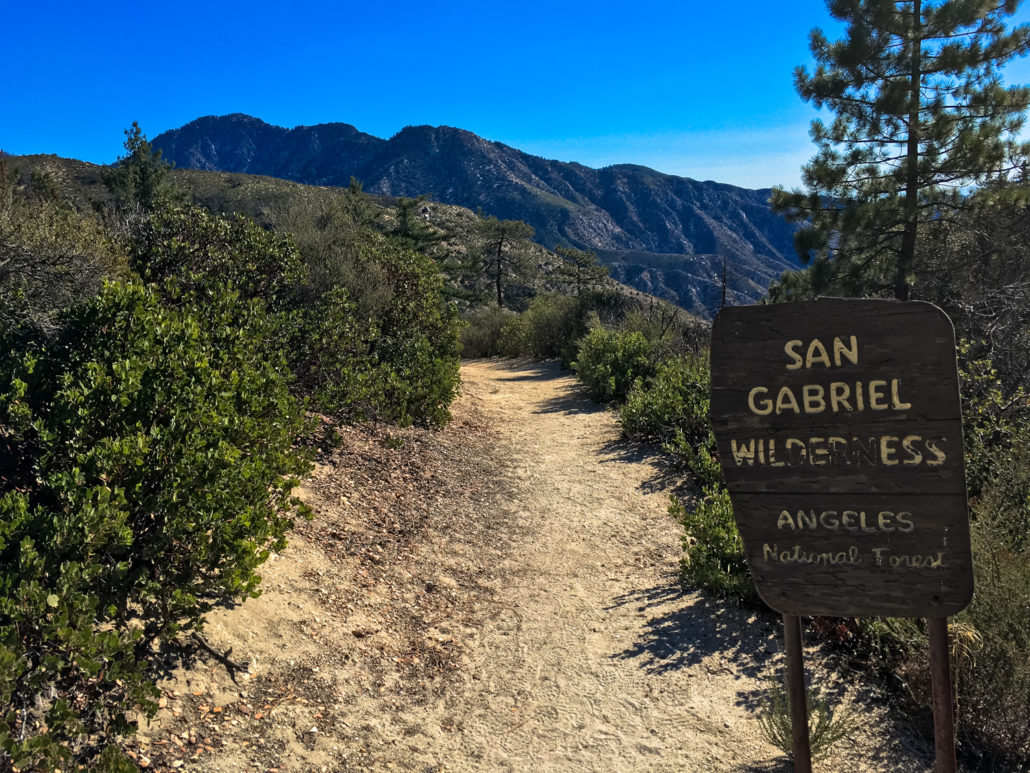The hike into Devil’s Canyon in the San Gabriel Wilderness will take you into a wooded canyon where a mostly-reliable creek flows past a picturesque and surprisingly secluded backcountry campsite. For adventurous hikers, a waterfall lies further in the canyon as well, and the best part is that most other hikers easily overlook this trail — meaning it’s likely you’ll have the canyon all to yourself.
The trail begins near a clearly marked trailhead just before the turnoff to the Chilao Visitor Center. Look for the sign marking Devil’s Canyon and a small parking area with a port-o-potty.

The trail itself is very easy to follow – there are no branches or junctions and the trail has been repaired and maintained after the 2009 Station Fire did quite a number on this region. Carefully cross the Angeles Crest Highway and head on down the Devil’s Canyon Trail.

As the signs note, you’ll immediately be stepping into the San Gabriel Wilderness, which was designated in 1968. Group size is limited to 25 people here and campfires are prohibited year round (but backpacking stoves are allowed with a free permit). You don’t need a wilderness permit to day hike here, but if you’re staying overnight you’ll want to call the Angeles National Forest / San Gabriel Mountains National Monument HQ in Arcadia at 626-574-1613.
You’ll notice this is a canyon-destination trail, which means the highest point of elevation is at the beginning AND end of the hike — so make sure you leave a bit of energy in your reserves for the climb back out to the trailhead.
Almost right out of the gate, you’ll have expansive, sweeping views of the San Gabriel Wilderness as it starts its meandering switchback descent — looking down Devil’s Canyon to the south, and to the east you’ll see the massive form of Waterman Mountain and the nearby (and easily recognizable) dual summits of Twin Peaks.
The trail here is narrow — and has a tendency to get washed out in heavy winter rains or snowmelt — so tread carefully as you enjoy the shade from old growth bigcone Douglas-firs (and watch out for those enormous pinecones!).


The trail descends
For my fellow plant nerds, this is a great trail to hike with an app like iNaturalist. Not only is a transitional elevation space, but because you’re hiking through both exposed south-facing slopes and shaded north-facing slopes, you’re going to see a wide variety of plant life here that usually isn’t found in such close proximity. Those bigcone Douglas-firs are sharing space with huge colonies of sun-soaked white sage. Low-elevation California sagebrush can be found on the same trail as its higher elevation cousin Great Basin sagebrush. Purple nightshade is here — and you might spot some lingering patches of Poodle-dog brush from the wildfires (but as we get farther away from 2009’s Station Fire, you’re not likely to spot too many as other natives re-establish themselves).

Looking down Devil’s Canyon
At 1.5 miles, the trail hops down into one of the northernmost tributaries of Devil’s Canyon (which will eventually become the West Fork of the San Gabriel River). Don’t expect to find water here unless there’s been recent rain or an exceptional snow year, but you will note that the plant life gets a heck of a lot more dense around here. It can be especially lovely in the late fall / early winter, when the sycamore leaves here start to turn a golden hue.


The trail moseys toward the southeast, taking time to hop in and out of the creek bed as it makes its way down. Not a lot of hikers head down here, so the trail tends to get a bit fainter the further you trek, but if you keep your eyes peeled you shouldn’t have trouble sticking to the established trail.
At 2.6 miles, the route gets a bit overgrown, but in another 0.2 mile you’ll join the wider, wetter expanse of Devil’s Canyon proper. Devil’s Canyon Creek flows year-round here except in drought years, and the addition of a bit of running water — even if it’s just a verrrrry tiny bit — makes this already lovely hike even lovelier.

In another 0.1 mile, the trail reaches a broad, cleared out backcountry campground on the creek’s west bank.

The established trail ends at the campground, which makes an excellent overnight spot or just a nice shady place to open up your sandwich and snacks and rest up before you climb out of the canyon.
Beyond the campsite, an unmaintained and VERY rough “trail” continues south in Devil’s Canyon to Devil’s Canyon Falls. It’s 2 miles of rough, tough bushwhacking and boulder-hopping on a very faint trail that is more often not there than there, so if you’re going to venture past the campground be sure you have lots of time and a good map of the region. Anyone who wishes to proceed beyond the falls will need experience with technical rock climbing and proper equipment — don’t go any further if you’re just hiking in, please.
Tags: Angeles National Forest, devil's canyon, San Gabriel Mountains, San Gabriel Wilderness














